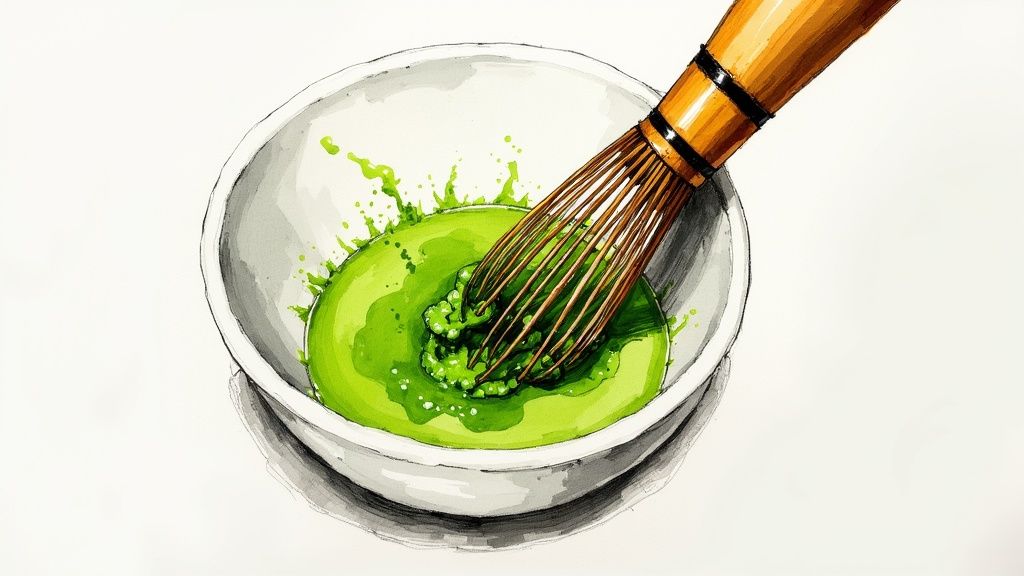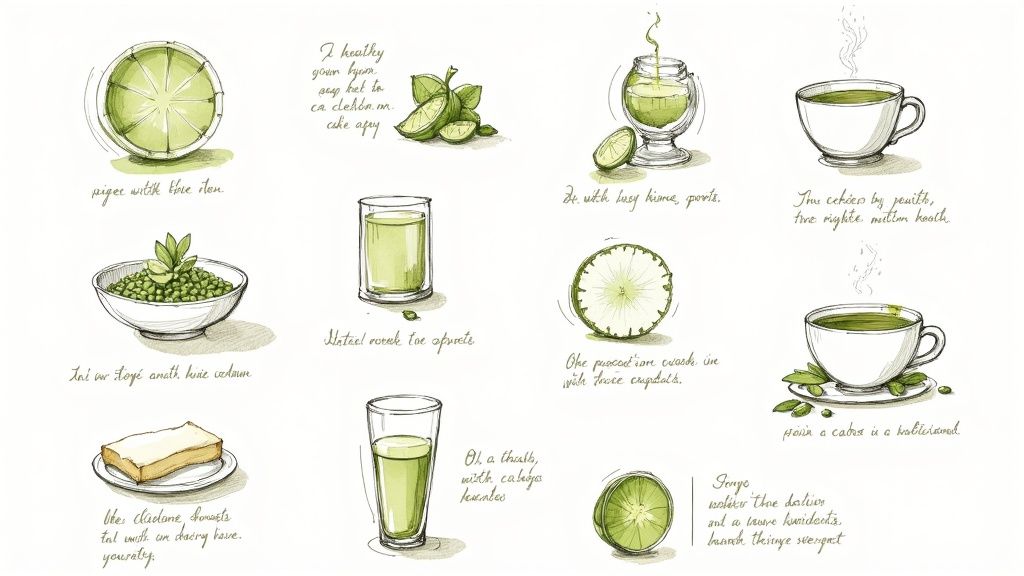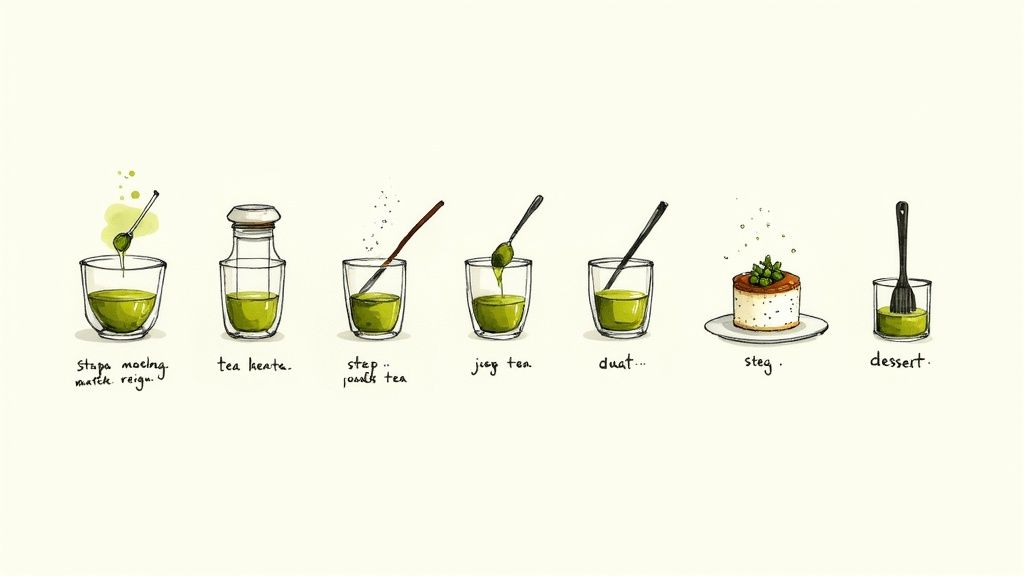The Power Behind Matcha's Antioxidant Profile

The brilliant green color of matcha isn't just visually striking – it signals the presence of powerful antioxidant compounds backed by scientific research. Let's explore what makes this traditional Japanese tea such an exceptional source of protective nutrients.
Understanding Matcha's Unique Cultivation
What sets matcha apart starts in the tea fields. For 20-30 days before harvest, farmers carefully shade the tea bushes, triggering remarkable changes in the leaves. This period of limited sunlight causes the plants to produce more chlorophyll, resulting in matcha's characteristic deep green hue. The shading process also boosts amino acid production, which creates matcha's complex flavor notes. Most importantly, this traditional growing method significantly increases antioxidant levels in the leaves, making each serving of matcha an concentrated source of these beneficial compounds.
The Significance of EGCG and ORAC
At the heart of matcha's antioxidant power is epigallocatechin gallate (EGCG), a particularly potent type of catechin. Thanks to the specialized shading process, matcha contains up to 137 times more EGCG than standard green tea. Another key measure is the Oxygen Radical Absorbance Capacity (ORAC) score, which rates a food's antioxidant strength. With an impressive 1300 ORAC units per gram, matcha outperforms many other antioxidant-rich foods. These high numbers reflect matcha's exceptional ability to neutralize free radicals – unstable molecules that can damage cells through oxidative stress. Think of matcha's antioxidants as a protective shield for your cells against these harmful compounds.
The Whole-Leaf Advantage and Bioavailability
The way we consume matcha makes a crucial difference in how effectively our bodies absorb its beneficial compounds. Unlike regular green tea where we discard the leaves after steeping, matcha involves consuming the entire tea leaf in powdered form. This means we get the complete nutritional benefits, similar to how taking a vitamin injection provides faster absorption than a slow-release capsule. By drinking the whole leaf, your body can better utilize matcha's antioxidants and other nutrients compared to steeped tea. This enhanced absorption helps matcha more effectively fight oxidative damage and support overall health. These unique properties set the stage for matcha's wide-ranging effects on mental clarity, heart function, and metabolism.
Unlocking Mental Clarity and Focus with Matcha

When you drink matcha, your body absorbs its antioxidants more effectively compared to regular green tea, leading to noticeable improvements in how your brain functions. Unlike coffee's intense but short-lived energy spike, matcha provides steady, clean energy without making you feel jittery or crash later. This comes from the special way L-theanine and caffeine work together in matcha to support mental performance.
The Dynamic Duo: L-Theanine and Caffeine
L-theanine is a natural compound found mainly in tea leaves that teams up with caffeine to create what scientists call "calm alertness." Picture an orchestra where caffeine acts as the energizing conductor while L-theanine keeps everything smooth and balanced. For example, if you're working on a complex project, L-theanine helps filter out mental noise so you can stay focused on what matters. Many people describe feeling both alert and relaxed at the same time.
Matcha's Cognitive Benefits: Beyond the Buzz
The combination of compounds in matcha supports brain function in several key ways:
- Sustained Attention: With L-theanine and caffeine working together, you can focus for longer without getting mentally tired
- Improved Memory: Research suggests matcha may help you remember information better and process it more quickly
- Enhanced Reaction Time: The alert mental state from matcha can help you respond faster in daily activities
These benefits make matcha especially helpful when you need to concentrate deeply, whether you're studying for an exam or preparing an important presentation. While early research is promising, scientists are still exploring exactly how matcha affects cognition.
Timing and Dosage: Maximizing Matcha's Mental Clarity
Getting the most mental benefit from matcha depends on when and how much you drink. Start with a small amount (½ – 1 teaspoon) and adjust based on how you feel. Here's when to drink matcha for best results:
- Morning: Start your day with matcha for steady energy that lasts
- Pre-Workout: Drink matcha before exercise to feel mentally and physically ready
- Afternoon Slump: Instead of coffee or sweets, have matcha to regain focus and productivity
By learning how matcha's natural compounds support your brain, you can use it effectively to improve your mental clarity and focus throughout the day.
Heart Health Benefits You Can't Ignore
When exploring matcha's many health benefits, its effects on heart health stand out as particularly significant. By supporting healthy cardiovascular function in multiple ways, matcha helps protect one of your body's most essential organs.
The Catechin Connection: How Matcha Supports Your Cardiovascular System
At the core of matcha's heart-protecting abilities are catechins, especially EGCG, which give the tea its rich green color. These natural compounds work to protect your cardiovascular system by fighting oxidative stress – much like how rust protection shields metal from corrosion. The catechins in matcha act as a protective barrier for your heart and blood vessels. Along with catechins, matcha contains rutin, a plant compound that adds to its heart-healthy properties. Together, these natural substances provide comprehensive support for cardiovascular wellness.
Blood Pressure, Cholesterol, and Inflammation: Matcha's Triple Threat
Matcha's benefits target three key areas of heart health. First, research indicates it helps maintain healthy blood pressure, reducing stress on the heart. Second, it supports balanced cholesterol levels, particularly helping to manage LDL (commonly known as "bad" cholesterol). Third, it helps reduce inflammation throughout the body. Since ongoing inflammation can harm blood vessels and raise heart disease risk, matcha's anti-inflammatory effects help keep arteries healthy and blood flowing smoothly.
Incorporating Matcha into a Heart-Healthy Lifestyle
Making matcha part of your daily routine fits naturally with other heart-healthy habits. For instance, drinking matcha before exercise provides steady energy without coffee's jittery effects. You might find this article on The health benefits of matcha tea helpful for learning more. Simply switching your afternoon coffee or sugary drink for a matcha latte can help maintain stable energy levels throughout your day.
Matcha's Heart Health Benefits: A Summary
| Benefit | How Matcha Helps |
|---|---|
| Blood Pressure | May contribute to healthy blood pressure levels, reducing strain on the heart and arteries. |
| Cholesterol | May help maintain healthy cholesterol levels, particularly LDL cholesterol. |
| Inflammation | Contains anti-inflammatory properties that protect blood vessels. |
| Oxidative Stress | Rich in antioxidants, particularly EGCG, which combats oxidative stress. |
While scientists continue studying matcha's effects on heart health, current research suggests that adding matcha to your daily routine supports a healthy heart and circulation system.
"Maximizing Your Metabolism with Matcha"
Maximizing Your Metabolism with Matcha

Matcha tea does more than provide antioxidants and mental clarity – it can also give your metabolism a natural boost. Let's explore how this powdered green tea supports healthy weight management when combined with balanced nutrition and regular exercise.
Understanding Matcha's Metabolic Boost
The combination of caffeine and EGCG in matcha creates a powerful effect on metabolism. Caffeine helps your body burn more calories, even while resting. When paired with EGCG (a beneficial compound found in high amounts in matcha), this effect becomes even stronger through increased thermogenesis – your body's heat and calorie-burning process. Think of it like building a campfire – just as using both small kindling and larger logs creates a stronger, longer-lasting flame, caffeine and EGCG work together to keep your metabolism humming along steadily. Unlike coffee, matcha provides sustained energy without the jitters, making it ideal for supporting weight management goals naturally.
The Role of EGCG in Fat Oxidation
EGCG does more than boost metabolism – it helps your body burn fat more efficiently. Just as a car runs better on premium fuel, EGCG helps your body tap into fat stores for energy more effectively. This improved fat-burning capacity can support gradual weight loss and better body composition over time when combined with healthy eating and exercise habits.
Timing Matcha for Optimal Metabolic Benefits
When you drink your matcha matters. Having a cup before exercise provides clean energy from the caffeine-L-theanine combination, helping you work out longer and stronger. An afternoon matcha can also prevent energy crashes that lead to unhealthy snacking. By timing your matcha strategically, you can maximize its metabolism-supporting benefits throughout the day.
Matcha and a Balanced Lifestyle
While matcha can support metabolic health, it works best as part of an overall healthy lifestyle. Focus on eating whole, nutritious foods, staying active with regular exercise, and managing stress effectively. Think of matcha as a helpful addition to these foundational habits – not a quick fix. When you combine matcha with balanced nutrition and consistent physical activity, you create the right conditions for achieving and maintaining your health goals naturally.
Understanding Matcha's Superior Absorption
The way matcha is prepared plays a key role in how well your body absorbs its beneficial compounds. Following traditional preparation methods helps unlock the full potential of this bright green tea powder, so you get the most from each serving.
The Whole-Leaf Advantage: A Nutritional Powerhouse
What makes matcha unique is that you consume the entire tea leaf, not just the steeped water like with regular green tea. When you drink matcha, you get all the vitamins, minerals, antioxidants and other beneficial plant compounds present in the leaves. With regular green tea, many of these nutrients stay trapped in the discarded leaves. This simple difference explains why matcha packs such powerful health benefits – you're getting everything the tea leaf has to offer.
Maximizing Bioavailability: The Art of Matcha Preparation
The traditional whisking method does more than create a pleasant frothy texture. When you vigorously whisk matcha powder with hot (not boiling) water, it breaks down the cell walls of the tea leaves and releases their nutrients. This makes it much easier for your body to absorb compounds like EGCG, a potent antioxidant that helps protect your cells from damage. The careful whisking creates a fine suspension that your digestive system can process efficiently.
Common Mistakes to Avoid: Preserving Matcha's Potency
Small preparation mistakes can reduce how much nutrition you get from your matcha. Using water that's too hot can damage delicate compounds like EGCG. Leaving clumps of powder means parts won't be properly broken down for absorption. Poor storage – letting matcha sit exposed to light, air and moisture – also degrades its nutritional content over time. Getting the basics right makes a big difference.
Optimal Preparation: Unleashing Matcha's Full Potential
Follow these key tips to get the most from your matcha:
- Water Temperature: Use hot water around 175°F (80°C) to protect the nutrients
- Whisking Technique: Use a bamboo whisk in a "W" or "M" motion until frothy for even distribution
- Storage: Keep in an airtight container in a cool, dark, dry place to maintain freshness
Taking care with these preparation steps ensures you get the full spectrum of health benefits in each bowl of matcha. This mindful approach makes every sip count toward supporting your wellbeing through proper nutrient absorption.
Your Complete Guide to Maximizing Matcha Benefits

Getting the most from your matcha requires attention to detail, from selection to preparation. Let's explore practical ways to optimize your matcha experience and ensure you receive all its wonderful health benefits.
Choosing High-Quality Matcha: A Guide to Grades and Sourcing
The quality of your matcha directly affects both its taste and health properties. The highest tier, ceremonial grade, features a vibrant green color and silky texture – perfect for traditional preparation. Premium grade offers excellent quality with a slightly stronger flavor, making it versatile for both pure matcha and recipes like lattes. For baking and cooking, culinary grade provides a cost-effective option without sacrificing the core benefits. When shopping, look for matcha from Japan, particularly regions like Uji, where centuries of expertise ensure authentic, high-quality tea.
Proper Storage: Preserving Matcha's Freshness and Potency
Like fine wine, matcha needs proper storage to maintain its quality. Light, air, and moisture can quickly diminish both its beautiful green color and beneficial compounds. Store your matcha in an airtight container in the refrigerator, away from light and moisture. This simple step helps preserve the tea's EGCG content and other valuable nutrients that make matcha such a healthy choice.
Mastering the Art of Matcha Preparation: Techniques and Tools
Making matcha is both an art and a science. The traditional method uses a bamboo whisk (chasen) and special bowl (chawan) to create a smooth, frothy consistency. For busy mornings, a milk frother works well too. Water temperature plays a crucial role – use water around 175°F (80°C) to bring out matcha's sweet notes without extracting bitter compounds. This gentle preparation preserves the tea's nutrients while creating the perfect cup.
Creative Ways to Incorporate Matcha Into Your Daily Routine
Matcha's mild, earthy flavor works beautifully in many dishes beyond the traditional tea bowl. Start your day with a matcha smoothie packed with fruits and greens, or enjoy an afternoon matcha latte for sustained energy. Mix it into yogurt, oatmeal, or homemade energy balls for healthy snacks throughout the day. You can even add matcha to pestos and marinades for a unique umami boost. The key is finding simple ways to include this nutrient-rich tea in meals you already enjoy.
Ready to start your matcha journey? Find authentic Japanese matcha perfect for your needs at matcha-tea.com.
